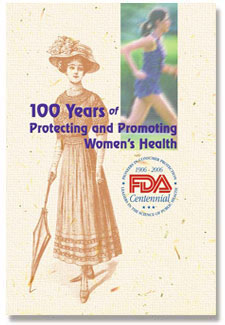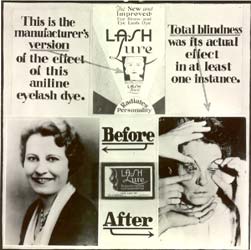 |
 |
 |
 |
 |
|
FDA Home Page | Search FDA Site | FDA A-Z Index | Contact FDA
![]()
 |
Every morning when you wake up and brush your teeth put in your contact lenses microwave your breakfast take your medicine feed your pet select a lipstick go grocery shopping get a flu shot or a mammogram.... You have been touched by the
|
The Food and Drug Administration (FDA) is America's oldest consumer protection agency. Throughout its 100-year history, the FDA has been working to improve the health of all Americans including some special programs for American women. The FDA's responsibilities have changed dramatically over this time, in response to public tragedies as well as scientific discoveries.
FDA regulates over 1 trillion dollars worth of products, which account for 25 cents of every dollar spent annually by American consumers. As part of its consumer protection role, FDA regulates a wide array of products:
This booklet outlines the FDA's historical and present role as a public health agency. It will also serve as a resource for information about its duties and where to get more information about foods, drugs, medical devices, biological products and cosmetics regulated by FDA.
Get more information about the FDA's mission and responsibilities.
For this brochure, we chose products important to women throughout their lives and for different diseases and conditions. However, only the first of a kind is listed. Please note that mention of a product does not constitute an endorsement.
Problem: Some syrups to calm colicky babies and "tonics" for women contained alcohol, opium, or morphine, addicting many who used them. Worthless, impure and dangerous patent medicines, and foods that were misrepresented or impure were on the market.
Response: Because of these problems, women organized to support the Food and Drugs Act of 1906. To protect the public's health, the law:
Get more information about FDA history.
An exhibit of dangerous food, medicines, medical devices and cosmetics was prepared to illustrate the shortcomings of the 1906 law. First Lady Eleanor Roosevelt took this exhibit to the White House and appealed to America's women to campaign for stronger protections for consumers.

The famous exhibit included the following harmful products:
Problem: A company manufacturing one of the first wonder drugs against infection (sulfanilamide) dissolved it in a poisonous liquid. Before the problem was discovered, 107 people, mostly children, died. Until this time, there were no government regulations requiring that drugs be tested and found safe before going on the market.
Response: As a result, Congress passed the federal Food, Drug, and Cosmetic Act of 1938. The new law:
Get more information about the Food, Drug, and Cosmetic Act.

In 1945, the Army developed a flu vaccine that cut the rate of infection by 75%. By 1946, it became available to civilians. Many women remembered family stories about the 1918 flu pandemic which had killed 675,000 people--a loss reported to have affected someone from every family in America.
Get more information about birth control.
Problem: In Europe, approximately 10,000 infants born with deformed arms and legs were linked to thalidomide, a drug their mothers had taken during pregnancy.
Response: Due to the efforts of a woman scientist and drug reviewer Frances Kelsey, (M.D./ Ph.D.), FDA did not approve the drug for use in America. Worldwide alarm led to stronger drug laws here and in many other countries. In the U.S., the 1962 Kefauver-Harris Amendments to the federal Food, Drug, and Cosmetic Act of 1938:
Get more information about thalidomide.
To prevent complications in Rh negative mothers, FDA licensed Rh immunoglobulins.
Problem: Since 1948, diethylstilbestrol (DES) had been prescribed (without the supporting scientific data) to thousands of pregnant women believed to need more estrogen to maintain their pregnancies. Exposed in the womb to DES, the daughters developed a rare form of vaginal cancer.
Response: FDA changed the labeling on this hormone to warn women against taking this drug during pregnancy.
Get more information about healthy babies.
Women in Clinical Trials
|
Problem: Approximately 2 million women had a contraceptive device, the Dalkon Shield IUD, inserted in their uteruses. Due to problems with this device, many women were seriously injured.
Response: In reacting to this tragedy, Congress passed the 1976 Medical Devices Amendments, which strengthened FDA's authority to oversee medical devices.
Problem: In 1980, there were 814 confirmed cases of menstrual related Toxic Shock Syndrome (TSS) and 38 deaths from the disease.
Response: FDA began requiring all tampon packages to include package inserts educating women about the risk of TSS and how to prevent it. In 1997, there were only five confirmed menstrually-related TSS cases and no deaths. The tampon package inserts with TSS information continue to be used today.
Get more information about toxic shock syndrome and tampons.
Problem: Seven people died from Tylenol capsules intentionally contaminated with cyanide.
Response: FDA issued regulations requiring tamper-resistant packaging for over-the-counter drugs.
Problem: Women and their doctors testified before Congress about problems with mammography, including untrained personnel, old machines, and failure to communicate test results.
Response: Congress passed the Mammography Quality Standards Act (MQSA), which imposed standards for mammography personnel, equipment, record keeping, and regular FDA inspections of mammography facilities. FDA also started an information service to help women find a quality mammography facility through the National Cancer Institute toll-free phone number (1-800-4-CANCER).
Get more information, including how to find a certified mammography center
FDA created the Office of Women's Health (OWH), beginning a new chapter in this agency's commitment to women's health. Serving as a champion for women's health both inside and outside the agency, OWH safeguards the health and well being of American women in a variety of ways by:
Problem: Data indicate that between family, work, and community responsibilities, women are often so busy taking care of others that they overlook their own health needs.
Response: OWH launched the "Take Time to Care" (TTTC) outreach initiative in 1998. Over the years, TTTC has become a multi-faceted campaign that focuses on the dissemination of health education materials through outreach activities and collaborative partnerships. OWH has also developed dozens of fact sheets and publications on topics including: heart disease, stroke, Lasik eye surgery, mammography, food safety, contraception, depression, HIV, osteoporosis, tattoos, Botox, menopause and hormones.
Since 1999, OWH has reached over 26 million consumers with its literature. OWH publications also are distributed through Internal Revenue Service and Congressional mailings. In 2005, OWH materials received the highest response of any mailing to Congress. An article in the nationally syndicated advice column Dear Abby promoting the Women's Health Education Kit sparked an overwhelming number of consumer requests for more than two million publications.
Congress amended the Federal Food, Drug and Cosmetic Act by passing the Food and Drug Administration Modernization Act (FDAMA). With the passage of FDAMA, Congress enhanced the FDA's mission to meet the challenges of the 21st century, such as establishing mechanisms to decrease the time FDA takes to review and approve applications. This Act also called for FDA to receive input from its stakeholders.
FDA held meetings across the country to exchange information with stakeholders on issues related to its regulation of drugs, biologics, medical devices, veterinary medicines, and foods, inspections of manufacturers, and FDAMA.
FDA called for a new focus on modernizing the tools that researchers and product developers use to assess the safety and effectiveness of potential new products and to mass-produce high-quality therapies. New scientific and technical tools—like laboratory tests, computer models based on past experience, and animal studies—will improve predictability and efficiency of products in development. These new tools will help create safe products that benefit patients.
We now have technologies that allow us to study each person in greater detail than ever before. We can understand the configuration of each individual's genes. We can understand how individuals react to the course of a disease and to a treatment. In the future, the public will see new tests and new therapies that are personalized to specific conditions and that can improve health while minimizing risk of serious side effects.
| U.S. Women | 1900's | 2000's |
|---|---|---|
| Age at death | 48 years | 80 years |
| Primary causes of death | TB and child birth | Heart disease |
| Average #children | 8 | 1.86 |
| Infant mortality rates | 124-158 per 1,000 | 7 per 1,000 |
| Number in workforce | Not counted | 59% |
| Eligible Voters | 0% | 51% |
This information reflects FDA's current analysis of data available to FDA concerning these products. The information in this booklet may also be found at www.fda.gov/womens/.
To report any unexpected adverse or serious events associated with the use of a medication, please contact the FDA MedWatch program at 1-800-FDA-1088 or www.fda.gov/medwatch/report/hcp.htm
![]()